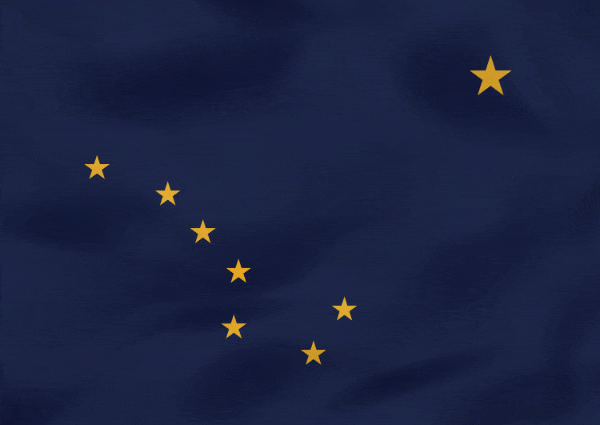Alaska
State abbreviation/Postal code: Alaska/AK Governor: Bill Walker, Independent (to Dec. 2018) Lieut. Governor: Byron Mallott, D (to Dec. 2018) Senators: Dan Sullivan, R (to Jan. 2021); Lisa Murkowski, R (to Jan. 2017) Historical biographies of Congressional members Atty. General: Jahna Lindenmuth (Since 2016) Organized as territory: 1912 Entered Union (rank): Jan. 3, 1959 (49) Constitution ratified: April 24, 1956 Motto: North to the Future
Nickname: The state is commonly called “The Last Frontier” or “Land of the Midnight Sun” Origin of name: Corruption of Aleut word meaning “great land” or “that which the sea breaks against” 10 largest cities (2013): Anchorage, 291,826; Fairbanks, 31,535; Juneau, 31,275 Sitka, 8,881; Wasilla, 7,831; Kenai, 7,100; Ketchikan, 8,050; Palmer, 5,937; Kodiak, 6,130; Bethel, 6,080; Land area: 570,641 sq mi. (1,477,953 sq km) Geographic center: 60 mi. NW of Mt. McKinley Number of boroughs (counties): 27 Largest borough by population and area: Anchorage, 298,294 (2012); Yukon-Koyukuk, 145,900 sq mi. State parks: more than 100 (3.5 million acres) Residents: Alaskan 2015 resident population: 738,432 2010 resident census population (rank): 710,231 (47). Male: 369,628 (51.7%); Female: 340,603 (48.3%). White: 473,576 (64.7%); Black: 23,263 (3.3%); American Indian and Alaska Native: 104,871 (14.8%); Asian: 38,135 (5.4%); Other race: 11,102 (1.6%); Two or more races: 51,875 (7.3%); Hispanic/Latino: 39,249 (5.5%). 2010 percent population 18 and over: 522,853; 65 and over: 54,938; median age: 32.8. |
Vitus Bering, a Dane working for the Russians, and Alexei Chirikov discovered the Alaskan mainland and the Aleutian Islands in 1741. The tremendous land mass of Alaska—equal to one-fifth of the continental U.S.—was unexplored in 1867 when Secretary of State William Seward arranged for its purchase from the Russians for $7,200,000. The transfer of the territory took place on Oct. 18, 1867. Despite a price of about two cents an acre, the purchase was widely ridiculed as “Seward's Folly.” The first official census (1880) reported a total of 33,426 Alaskans, all but 430 being of aboriginal stock. The Gold Rush of 1898 resulted in a mass influx of more than 30,000 people. Since then, Alaska has contributed billions of dollars' worth of products to the U.S. economy.
In 1968, a large oil and gas reservoir near Prudhoe Bay on the Arctic Coast was found. The Prudhoe Bay reservoir, with an estimated recoverable 10 billion barrels of oil and 27 trillion cubic feet of gas, is twice as large as any other oil field in North America. The Trans-Alaska pipeline was completed in 1977 at a cost of $7.7 billion. Oil flows through the 800-mile-long pipeline from Prudhoe Bay to the port of Valdez.
Other important industries are fisheries, wood and wood products, furs, and tourism.
Denali National Park and Mendenhall Glacier in North Tongass National Forest are of interest, as is the large totem pole collection at Sitka National Historical Park. The Katmai National Park includes the “Valley of Ten Thousand Smokes,” an area of active volcanoes.
The Alaska Native population includes Eskimos, Native Americans, and Aleuts. About half of all Alaska Natives are Eskimos. (Eskimo is used for Alaska Natives; Inuit is used for Eskimos living in Canada.) The two main Eskimo groups, Inupiat and Yupik, are distinguished by their language and geography. The former live in the north and northwest parts of Alaska and speak Inupiaq, while the latter live in the south and southwest and speak Yupik.
About a third of Alaska Natives are Native American. The major tribes are the Alaskan Athabaskan in the central part of the state, and the Tlingit, Tsimshian, and Haida in the southeast.
The Aleuts, native to the Aleutian Islands, Kodiak Island, the lower Alaska and Kenai Peninsulas, and Prince William Sound, are physically and culturally related to the Eskimos. About 15% of Alaska Natives are Aleuts.
On March 24, 1989, the oil tanker Exxon Valdez ran into a reef in the Prince William Sound, spilling 11 million gallons of crude oil along 1,500 miles of coastline. The massive clean-up effort lasted more than 3 years.
In the 2008 presidential elections, Alaska's first female governor, Sarah Palin, was chosen as Republican John McCain's running mate, becoming the GOP's first female candidate for vice president. She and McCain were defeated by the Democratic ticket of Barack Obama and Joe Biden.
In August 2015, President Barack Obama renamed Mount McKinley, restoring the Alaskan native name, Denali.
See more on Alaska:
Encyclopedia: Alaska.
Encyclopedia: Land and People
Encyclopedia: Economy
Encyclopedia: Government
Encyclopedia: History
Monthly Temperature Extremes
All U.S. States: Geography & Climate
Printable Outline Maps
Record Highest Temperatures
Record Lowest Temperatures
Highest, Lowest, and Mean Elevations
Land and Water Area
All U.S. States: Population & Economy
Historical Population Statistics, 1790–Present
Per Capita Personal Income
Minimum Wage Rates
State Taxes
Federal Government Expenditure
Percent of People in Poverty
Births and Birth Rates
Homeownership
Percentage of Uninsured by State
All U.S. States: Society & Culture:
Most Livable States
Healthiest States
Most Dangerous States
Smartest States
Crime Index
Residency Requirements for Voting
Compulsory School Attendance Laws
Driving Laws
National Public Radio Stations
Selected famous natives and residents:
- Clarence L. Andrews author;
- Aleksandr Baranov first governor of Russian America;
- Irene Bedard singer/actor;
- Margaret Elizabeth Bell author;
- Benny Benson designed state flag at age 13;
- Vitus Bering explorer;
- Charles E. Bunnell educator;
- Susan Butcher sled-dog racer;
- William A. Egan first state governor;
- Carl Ben Eielson pioneer pilot;
- Scott Gomez hockey player;
- Henry E. Gruennig political leader;
- B. Frank Heintzleman territorial governor;
- Walter J. Hickel governor;
- Sheldon Jackson educator and missionary;
- Joe Juneau prospector;
- Austin Lathrop industrialist;
- Sydney Lawrence painter;
- Ray Mala actor;
- Sarah Palin politician;
- Virgil F. Partch cartoonist;
- Joe Redington, Sr. sled-dog musher and promoter;
- Peter Trinble Rowe first Episcopal bishop;
- Ivan Popov-Veniaminov (St. Innocent) Russian Orthodox missionary;
- Ferdinand Wrangel educator;
- Samuel Hall Young founder of first American church.


